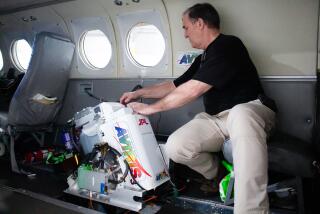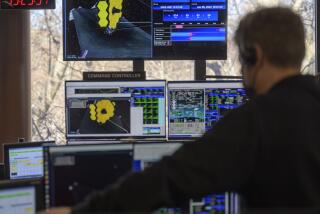Star Searcher : Tiny Detector Donated to UCI Is a Powerful Tool in Celestial Studies
IRVINE — It cost millions of dollars to develop, measures just a centimeter square and has the potential for helping UC Irvine researchers detect distant solar systems as they are still forming.
And fittingly, the tiny mirror-like object comes with a tongue-tying name to match its complicated design and function: the advanced infrared detector array.
The detector was donated to UCI this month by Rockwell International. Despite its tiny size, the detector can be a powerful tool in collecting and analyzing data about light and energy, UCI researchers said.
The device--developed by Rockwell as part of the Strategic Defense Initiative--is fairly common inside the defense industry. But only recently have astronomers and physicists begun using the detectors in their research.
One is Ron Garden, a UCI associate professor of physics. He hopes to use it to identify young stars and other celestial bodies that otherwise might go undetected.
“This is the next step for astronomy in terms of the size of the (device) and what it can detect,” said Garden, a 33-year-old native of Scotland who has worked at UCI for five years. “It’s very important. . . . Nothing else can touch it.”
Garden plans to attach the detector to a telescope that will collect infrared light from the solar system and focus it on the 16,000 sensors that cover the array.
What makes the array important to scientists is its ability to convert invisible infrared light into electric signals. When light reaches the detector, it is stored as an electric charge. The more infrared light that hits the sensors, the greater the charge.
By measuring the electric signals on each sensor, scientists hope to identify objects that are difficult to spot with a telescope. Theoretically, the detector will be able to identify forming stars, which are cooler and less bright than normal stars and therefore harder to see.
Garden also hopes the detector will give researchers a clearer view of portions of the galaxy that up to now have been obscured by thick interstellar dust.
All this could increase scientists’ understanding of space and especially of the way stars and solar systems form, experts said.
An added benefit of the detector is that the information it collects can be downloaded onto computers. “Then you can do anything you want with the data,” Garden said. “You can change colors, enhance certain features and images.”
UCI’s detector is one of just a handful being used in non-government research, said Richard Florence, a Rockwell manager who has worked with Garden.
It took millions of dollars and years of research to develop the devices, which cost about $40,000 each to produce, he said. Rockwell has received requests for detectors from scientists in the United States, Asia and Europe who are just now realizing their astronomical applications, Florence said. Even NASA is interested in the detectors.
“We’ve worked with Ron Garden for several years,” he said. “We feel he’s doing good astronomy work, and we wanted to help support him.”
Thanks to the donation, Garden received a $40,000 matching grant from the National Science Foundation that he will use to help fund his research. He expressed gratitude for the gift, saying the university could never afford to purchase such a device on its own.
If Garden has his way, he will use the detector with the famed Keck Telescope in Hawaii.
“With this good an instrument, you want to use the best telescope in the world,” he said.






